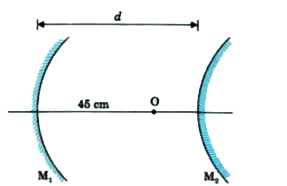When an object is placed at a distance of 25 cm from a mirror, the magnification is m1. The object is moved 15cm farther away with respect to the earlier position, and the magnification becomes m2. If m1/m2=4 , then calculate the focal length of the mirror. Solution in Gujrati
5 cm
10 cm
15 cm
20 cm
The correct Answer is:D
Since m1m2=4, therefore f+40f+25=4
thus f+40=4f+100
or f=−20cm
The negative sign shows that the mirror is concave.
Topper's Solved these Questions
Similar Questions
Find dydx for the following :
(i) y=x7/2 (ii) y=x−3
(iii)y=x (iv) y=x5+x3+4x1/2+7
(v) y=5x4+6x3/2+9x (vi) y=ax2+bx+C
(Vii)y=3x^(5)-3x-1/x
View SolutionWhen an object is placed at a distance of 25 cm from a mirror, the magnification is m1. The object is moved 15cm farther away with respect to the earlier position, and the magnification becomes m2. If m1/m2=4 , then calculate the focal length of the mirror.
View SolutionThe lateral magnification of the lens with an object located at two different position u_(1) and u_(2) are m_(1) and m_(2) , respectively. Then the focal length of the lens is
View SolutionThe focal length of a thin biconvex lens is 20cm. When an object is moved from a distance of 25cm in front of it to 50cm, the magnification of its image changes from m25 to m50. The ration m25/m50 is
View SolutionAn object O is placed in front of a small plane mirror M_(1) and a large convex mirror M_(2) of focal length f . The distance between O and M_(1) is x, and the distance between M_(1) and M_(2) is y. The images of O forned by M_(1) and M_(2) coincide. The magnitude of f is
View SolutionThe magnifications produced by a convex lens for two different positions of an object are m1 and m2 respectively (m1>m2). If 'd' is the distance of separation between the two positions of the object then the focal length of the lens is
View SolutionIn case of a concave mirror magnification is found to be m_(1) = -0.5 for a certain position of object and when object is displaced by 5 cm from this position then magnification is found to be m_(2) = -0.25 . What will be the focal length of the mirror?
View SolutionIn the following figure two mirrors M1andM2 are placed in front of each others.

Both the mirrors have same focal length of 30 cm. Mirror M1 is concave but mirror M2 is convex. Distance between the two mirrors is d and their principal axes are coinciding as shown in figure. An object O is placed on principal axis at a distance 45 cm from mirror M1. It is found that final image is formed on object itself. Calculate the value of d.
View SolutionWhen an object is placed at a distance of 25 cm from a concave mirror, the magnification is m1. The object is moved 15 cm farther away with respect to the earlier position, and the magnification becomes m2. If m1/m2=4 the focal length of the mirror is (Assume that image is real and m1,m2 are numerical value)
View SolutionWhen an object is placed at a distance of 25cm from a mirror, the magnification is m1. The object is moved 15 cm farther away with respect to the earlier position, and the magnification becomes m2. If m1m2 = 4, then calculate the focal length of the mirror.
View SolutionWhen an object is placed at a distance of 25 cm from a concave mirror, the magnification is m_1 . The object is moved 15 cm farther away with respect to the earlier position, and the magnification becomes m_2 . If m_1//m_2 = 4 the focal length of the mirror is (Assume that image is real and m_1, m_2 are numerical values)
View SolutionAn object O is placed in front of a small plane mirror M_(1) and a large convex mirror M_(2) of focal length f . The distance between O and M_(1) is x, and the distance between M_(1) and M_(2) is y. The images of O forned by M_(1) and M_(2) coincide. The magnitude of f is
View SolutionWhen an object is placed at a distance of 25 cm from a mirror, the magnification is m_1 . The object is moved 15 cm further away with respect to the earlier position, and the magnification becomes m_2 . If m_1//m_2=4 , the focal length of the mirror is
View SolutionThe focal length of a thin biconvex lens is 20cm .When an object in moved from a distance of 25cm infront of it to 50cm ,the magnification of the image changes from m_(1) to m_(2) .Find the ratio (m_(1))/(m_(2))
View SolutionWhen an object is placed at a distance of 25 cm from a mirror, the magnification is m1. The object is moved 15cm farther away with respect to the earlier position, and the magnification becomes m2. If m1/m2=4 , then calculate the focal length of the mirror.
View SolutionThe lateral magnification of the lens with an object located at two different position u_(1) and u_(2) are m_(1) and m_(2) , respectively. Then the focal length of the lens is
View Solution
